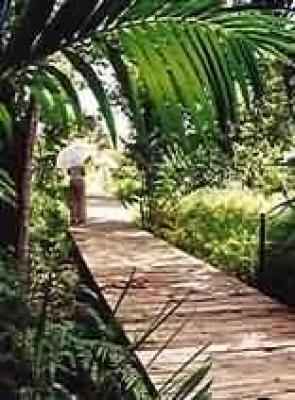The 159 ha garden straddles the Crocodile and Nels Rivers. The Crocodile surges through a narrow, solid rock gorge that has been scoured out and pot-holed over millennia, while the Nels River tumbles down a waterfall from the west, to converge with the Crocodile in a serene pool on a bend in the river.
Along the river banks you'll find typical riparian forest, belts which are evergreen. The steep slopes on the western side of the Crocodile River have more dense vegetation than the drier slopes on the eastern side of the river.
On the eastern bank of the Crocodile River there is an emergent, simulated, tropical African rainforest. It is a world first for the Lowveld Garden and represents the rapidly disappearing tropical rain forests of Central and West Africa.
The higher reaches of the Garden have been laid out taxonomically, although many of the species are also present in other sections e.g. there are cycads scattered over large parts of the Garden.
In addition to approximately 600 plant species occurring naturally in the Garden, more than 2000 additional species have been planted.
Of the approximately 1000 tree species indigenous to South Africa, over 650 can be seen in the garden --- this includes numerous species from sub-tropical southern Africa.
The Lowveld Garden is like an enormous arboretum and is characterised by its evergreen lawns and wealth of trees. Its unique, park-like ambience makes it a wonderful haven for the urban citizens of Nelspruit and overseas tourists.
The Garden is open daily from 08h00 to 18h00 (October to April) and 08h00 to 17h15 (May to September).
There is never that dramatic contrast between summer and winter that is experienced on the highveld, because many of the trees and shrubs are evergreen, especially in the riparian zones. The Lowveld National Botanical Garden is a joy to visit at any time of the year.

